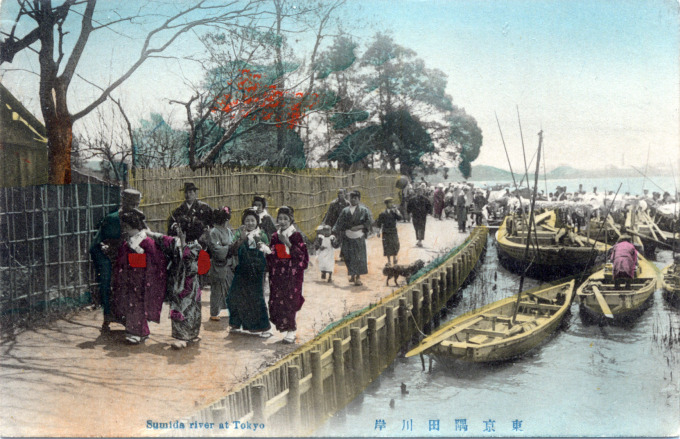
Sumida river ferry with passengers, c. 1910. In the distance can be seen a pair of natural gas storage tanks (Tokyo Gas Company?) in the industrialized area of the river north of Azumabashi.
See also:
Yanebune on the Sumida River, c. 1910.
Yaomatsu Restaurant, Mukojima, c. 1910
Hyappongui (100 Stakes), Sumida River, c. 1910.
“Ferries were a prominent motif in a rapidly changing vernacular of landscape. In the exceptionally rich topographical language of Edo-Tokyo, the ferries that cross the Sumida became one of the most evocative symbols of landscape change … They stood both for continued links with the city of Edo, the shoguns’ capital, and for the many features of the cultural landscape that were disappearing the rapidly industrializing city.
“… The passage from an early modern urban centre of power and consumption to a modernizing, industrializing imperial capital has been cast in terms of change from a water-based culture and economy to a land-based one, and one fashioned out of wood to one built of steel, from the fluid spontaneous rhythms of flowing water to the solid, angular patterns of functional planning.”
– Japanese Capitals in Historical Perspective: Place, Power and Memory in Kyoto, Edo and Tokyo, edited by Nicolas Fieve & Paul Waley, 2003
- Sumida ferry landing, c. 1910.
- Ferry landing at Mukojima, c. 1910.
- A yakata-bune glides along the Sumida River, c. 1910.
- Sumida river ferry, c. 1910.
- Kototoi ferry boat landing, c. 1910.
- Makurabashi ferry landing on the Sumida River, across from Asakusa, c. 1910.
- Mukojima ferry boat landing, c. 1910.
- An excursion boat passing beneath the Ryougoku-bashi, c. 1910. In the distance can be seen the national sumo hall, Kokugikan.
“When the blossoms are out in April, Mukojima is densely crowded with holiday-makers from morn til dusk, and the tea-houses on the banks and the boats on the river re-echo with music and merriment. This sight, which lasts about a week, should on no account be missed. The noted Yaomatsu tea-house stands close by.”
– A Handbook for Travellers in Japan: Including the Whole Empire from Yezo to Formosa, Basil Hall Chamberlain & W. B. Mason, 1909









